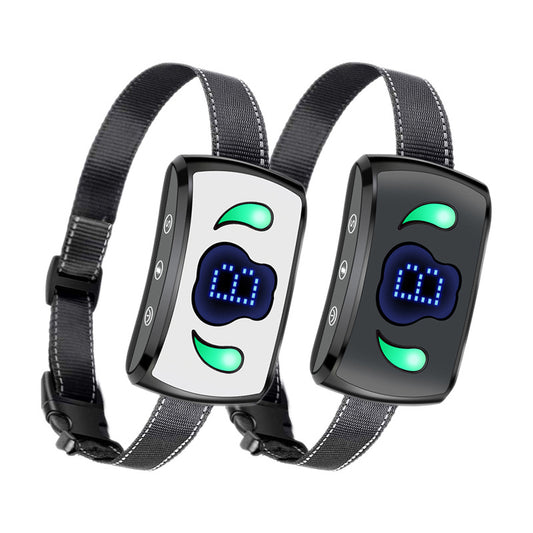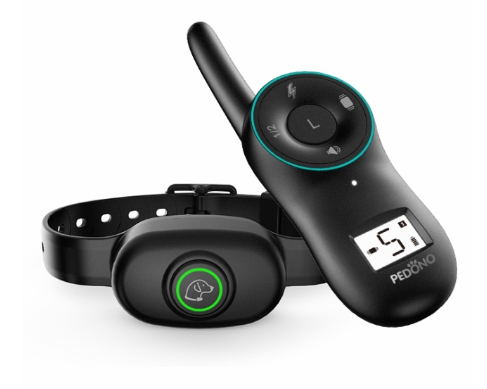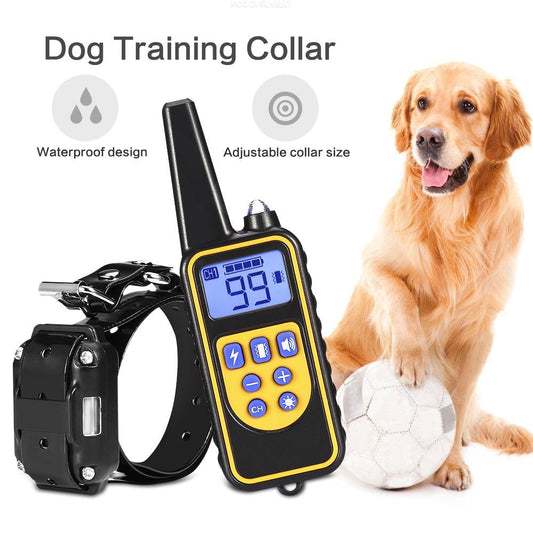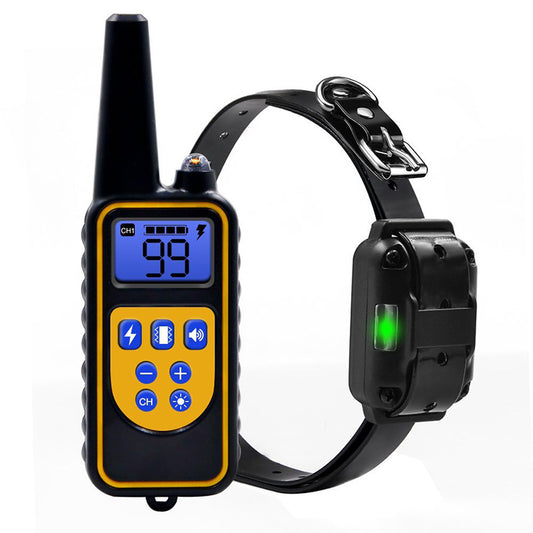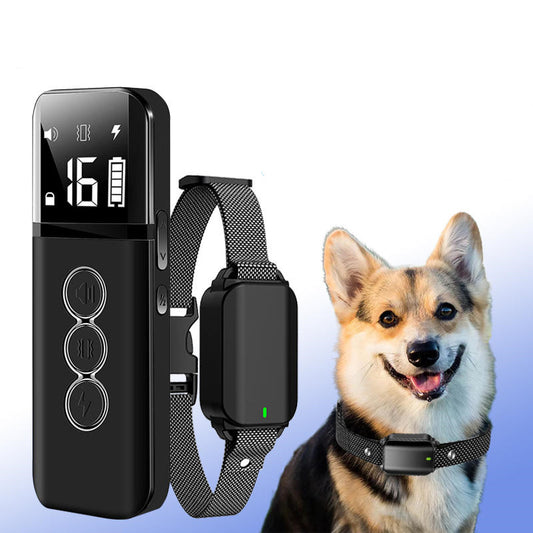The Complete Guide About Dog Training Collars
Dog training collars are an effective tool for correcting unwanted behaviours and promoting good behaviour in your furry friend. With so many options available, it can be challenging to know which collar is right for your pet. In this guide, we'll explore the world of dog training collars, their features, and how to choose the perfect one for your pet.
Understanding Dog Training Collars
Dog training collars are designed to correct unwanted behaviours and promote good behaviour in dogs. Here are some subheadings and bullet points to consider:
-
Training Method: Dog training collars work by using various training methods, such as positive reinforcement, negative reinforcement, and punishment.
-
Training Techniques: Dog training collars can be used to correct various unwanted behaviours, such as barking, jumping, and pulling on the leash.
-
Type of Collar: Dog training collars come in various types, such as shock collars, head collars, and bark collars.
Types of Dog Training Collars
Dog training collars come in different types and offer various features. Here are some of the most popular ones:
-
Remote Dog Training Collar: A remote dog training collar is a collar that uses a remote control to deliver a correction to the dog.
-
Head Collar: A head collar is a collar that goes around the dog's nose and neck, providing more control during walks.
-
Bark Collar: A bark collar is a collar that delivers a correction when the dog barks excessively.
Features of Dog Training Collars
Dog training collars offer various features that make them useful for correcting unwanted behaviours. Here are some subheadings and bullet points to consider:
-
High Quality: Choose a dog training collar that is made of high-quality materials and is durable.
-
Battery Life: Choose a dog training collar with a long battery life to avoid frequent charging or replacement.
-
Training Tool: Dog training collars are a training tool, not a substitute for proper training and socialization.
-
Stops Barking: Some dog training collars are designed specifically to stop excessive barking.
Benefits of Using a Dog Training Collar
Using a dog training collar has many benefits for both the dog and the owner. Here are some subheadings and bullet points to consider:
-
Training: Dog training collars can be used as a training tool to teach obedience and good behavior.
-
Unwanted Behaviors: Dog training collars can help correct unwanted behaviors, such as jumping, barking, and pulling on the leash.
-
Dog Attention: Dog training collars can help redirect the dog's attention away from distractions and back to the owner.
-
Small Dog: Dog training collars can be especially useful for small dogs who may be more difficult to control during walks.
Heading 5: Choosing the Right Dog Training Collar
Choosing the right dog training collar can be overwhelming, but it doesn't have to be. Here are some subheadings and bullet points to consider when selecting the perfect dog training collar:
-
Purpose: Consider the purpose of the dog training collar. Is it for everyday wear, training, or outdoor activities?
-
Size: Measure your dog's neck and choose a collar that fits properly. Make sure the collar is comfortable and not too heavy.
-
Type of Correction: Choose a dog training collar that uses a correction method that is appropriate for your pet's behavior.
-
Battery Life: Choose a dog training collar with a long battery life to avoid frequent charging or replacement.
The Importance of Positive Reinforcement Training
Positive reinforcement training is a training technique that rewards good behavior and encourages the dog to repeat the behavior. Here are some subheadings and bullet points to consider:
-
Benefits: Positive reinforcement training has been shown to be more effective and humane than punishment-based training.
-
Training Techniques: Positive reinforcement training can be used in conjunction with dog training collars to promote good behavior and teach obedience.
-
Training Tools: Dog training collars should be used as a training tool in conjunction with positive reinforcement training and not as a substitute.
The Controversy Surrounding Shock Collars
Shock collars are a type of dog training collar that delivers an electric shock to the dog's neck as a form of punishment. Here are some subheadings and bullet points to consider:
-
Safety: Shock collars can cause physical harm to dogs and should be used with caution.
-
Effectiveness: Shock collars have been shown to be less effective than positive reinforcement training in promoting good behavior.
-
Alternatives: There are many alternatives to shock collars, such as head collars and bark collars.
Using a Dog Trainer
If you're unsure which dog training collar to choose or how to use it properly, consider hiring a professional dog trainer. Here are some subheadings and bullet points to consider:
-
Expertise: A dog trainer has the expertise and knowledge to select the perfect dog training collar and teach you how to use it properly.
-
Cost: Hiring a dog trainer can be costly, but it can save you time and frustration in the long run.
-
Follow-Up: A dog trainer can provide follow-up training and support to ensure you and your pet are successful in using the dog training collar.
The Martingale Collar
The Martingale collar is a type of collar that is designed to prevent dogs from slipping out of their collars. Here are some subheadings and bullet points to consider:
-
Design: The Martingale collar has two loops that tighten when the dog pulls on the leash, preventing the dog from slipping out of the collar.
-
Training Tool: The Martingale collar can be used as a training tool to teach dogs not to pull on the leash.
-
Size: The Martingale collar comes in different sizes to fit various neck sizes.
How to Use a Dog Training Collar Properly
Using a dog training collar properly is essential for promoting good behavior and avoiding harm to your pet. Here are some subheadings and bullet points to consider:
-
Follow Instructions: Always follow the manufacturer's instructions for using the dog training collar.
-
Start Slowly: Introduce the dog training collar gradually and use it for short periods at first.
-
Use Positive Reinforcement: Always use positive reinforcement when using a dog training collar.
-
Seek Help: If you're unsure how to use the dog training collar properly, seek help from a professional dog trainer.
Tips for Using a Remote Dog Training Collar
Remote dog training collars are a popular option for training dogs. Here are some subheadings and bullet points to consider:
-
Introduce Slowly: Introduce the remote dog training collar slowly to avoid overwhelming your pet.
-
Choose the Right Correction Level: Choose the right correction level based on your pet's behavior and training needs.
-
Be Consistent: Use the remote dog training collar consistently to promote good behavior and obedience.
-
Pair with Positive Reinforcement: Pair the use of the remote dog training collar with positive reinforcement training to promote good behavior.
Using Bark Collars for Excessive Barking
Bark collars are a type of dog training collar designed to stop excessive barking. Here are some subheadings and bullet points to consider:
-
Types of Bark Collars: Bark collars come in various types, such as spray, ultrasonic, and shock.
-
Proper Fit: Choose a bark collar that fits properly and is comfortable for your pet to wear.
-
Pair with Training: Use the bark collar in conjunction with training to promote good behavior and teach your dog not to bark excessively.
-
Use with Caution: Use the bark collar with caution and follow the manufacturer's instructions to avoid causing harm to your pet.
Common Myths about Dog Training Collars
There are many misconceptions and myths about dog training collars. Here are some subheadings and bullet points to consider:
-
Myth: Dog training collars are cruel and inhumane.
-
Fact: When used properly and with caution, dog training collars can be an effective and humane tool for promoting good behavior.
-
Myth: Dog training collars are a substitute for proper training and socialization.
-
Fact: Dog training collars are a training tool and should be used in conjunction with proper training and socialization.
-
Myth: All dog training collars are the same.
-
Fact: Dog training collars come in different types and offer various features, and it's essential to choose the right collar for your pet's behavior and training needs.
Common Mistakes to Avoid
Here are some common mistakes to avoid when using a dog-training collar:
- Using the wrong type of collar for your pet's behaviour.
- Using the dog training collar as a substitute for proper training and socialization.
- Overusing the dog training collar.
- Using the dog training collar on a pet with health issues.
- Not following the manufacturer's instructions.
Conclusion
Choosing the right dog training collar can be a daunting task, but it's essential to select a collar that is appropriate for your pet's behaviour and training needs. Positive reinforcement training is generally considered to be the most effective and humane training method, and dog training collars should be used as a training tool in conjunction with positive reinforcement training.
Remember to follow the manufacturer's instructions, use the collar with caution, and seek help from a professional dog trainer if needed. With the right dog training collar and training techniques, you can promote good behaviour and obedience in your furry friend while strengthening your bond and relationship.
Frequently Asked Questions
Can dog training collars cause harm to dogs?
Answer: Yes, dog training collars can cause harm to dogs if not used properly. It is essential to follow the manufacturer's instructions and use the collar with caution.
What is the most effective type of dog training collar?
Answer: The most effective type of dog training collar depends on your pet's behavior and training needs. Positive reinforcement training is generally considered to be the most effective and humane training method.
Can dog training collars be used on small dogs?
Answer: Yes, dog training collars can be used on small dogs, but it's essential to choose a collar that fits properly and is not too heavy.
What is the battery life of a typical dog training collar?
Answer: The battery life of a dog training collar varies depending on the brand and model. Some collars have a battery life of up to several months, while others require frequent charging or replacement.
Can dog training collars be used with positive reinforcement training?
Answer: Yes, dog training collars can be used with positive reinforcement training to promote good behavior and obedience in dogs.

